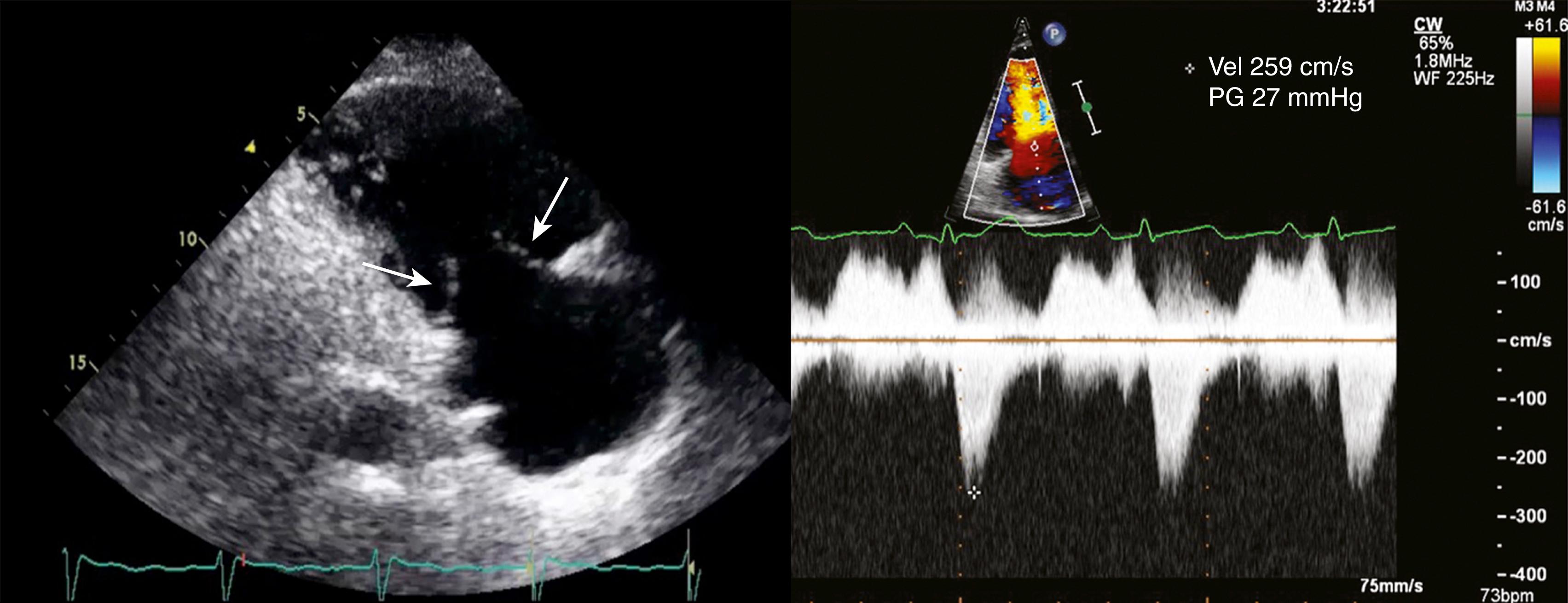Physical Address
304 North Cardinal St.
Dorchester Center, MA 02124
Tricuspid stenosis (TS) is the least common stenotic valvulopathy. TS is most commonly the result of rheumatic heart disease (RHD). Isolated involvement of the tricuspid valve (TV) is seen in congenital TS or in carcinoid heart disease. Other causes include metabolic or enzymatic abnormalities such as Fabry and Whipple disease.
Rheumatic TS. RHD, although infrequent in developed countries, accounts for the majority (>90%) of all cases. Approximately 3% to 5% of patients with rheumatic mitral disease have concomitant TS. , Large majority of patients with rheumatic TS have coexisting mitral valve involvement. Diffuse fibrous leaflet thickening with commissural fusion, especially the anteroseptal commissure, is typical. Chordal involvement in TS is less pronounced than in rheumatic mitral stenosis (MS).
Congenital TS. Isolated TV involvement is usually caused by congenital lesions. Although rare, Ebstein anomaly can result in TS.
Carcinoid heart disease. Carcinoid heart disease affects more than 50% of those with carcinoid tumor and almost exclusively involves the right heart. TV involvement can result in tricuspid regurgitation (TR), TS, or mixed disease. Vasoactive amines produced by the carcinoid tumor result in thick and rigid leaflets giving a frozen appearance. Chordae and papillary muscles may also be affected ( Fig. 108.1 ).

Video 108.1. A two-dimensional echocardiographic image of a tricuspid valve in a patient with carcinoid syndrome, obtained in a right ventricular inflow view in systole. Note the frozen appearance of the tricuspid leaflets (white arrows) .
Miscellaneous. Right atrial (RA) tumors or clots or infective endocarditis with vegetations may cause tricuspid obstruction mimicking TS. Rare cases of iatrogenic TS secondary to pacemaker leads have been reported. External right chamber compression from loculated pericardial effusion can result in elevated tricuspid gradients mimicking TS.
Prosthetic TS. Compared with left-sided bioprosthetic valves, TV prostheses generally have less durability. Prosthetic valve dysfunction may result in stenosis, regurgitation, or a combination of both. Common causes of prosthetic dysfunction include leaflet degeneration, valve thrombosis, endocarditis, and pannus formation.
TS severity is defined by the diastolic pressure gradient between the right-sided chambers. Mean gradients of 4 mmHg and above generally lead to high RA pressure and systemic venous congestion. Simultaneously, the right ventricle is underfilled, leading to low cardiac output. As a result, patients with concurrent MS may not exhibit significant elevation of left atrial, pulmonary artery (PA), or right ventricular (RV) systolic pressures.
Patients with hemodynamically significant TS present with signs and symptoms of elevated venous pressures, including fatigue, edema, anasarca, and congestive hepatomegaly. Patients have relatively little dyspnea for the degree of systemic venous congestion. Jugular venous pulsations may show a prominent A wave with a slow Y descent (reflecting delayed emptying of the RA). In atrial fibrillation, a positive CV systolic wave with a slow Y descent can be seen. On auscultation, TS may produce a soft opening snap followed by a middiastolic rumbling murmur with presystolic accentuation at the parasternal border in the fourth intercostal space. The murmur intensity (and the diastolic pressure gradient) increases with maneuvers that increase venous return such as leg raising, inspiration, squatting, and exercise.
Become a Clinical Tree membership for Full access and enjoy Unlimited articles
If you are a member. Log in here